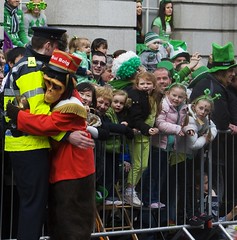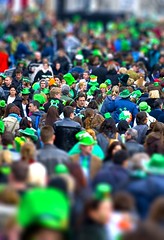


Photos from www.pix.ie.
St. Patrick's Day Parade
By Maggie Harpur



Photos from www.pix.ie.
Considering that St. Patrick’s Day is a holiday associated with Ireland, it should be expected that the country would throw one of the most magnificent celebrations in the world for it. Each year, the country shows its pride with the six-day St. Patrick’s Festival in Dublin.
The Government of Ireland established this event in 1995 so that the Irish could really “own” St. Patrick’s Day. In 1996, this was a one-night festival, and it took only five months to plan; now, the festival is almost a weeklong and planning for the event takes 18 months. The audience has also grown considerably; 430,000 people attended the first St. Patrick Festival and in 2001, just five years later, 1.2 million people attended the event. Over one million people were expected to attend this year’s St. Patrick’s Festival, including 50,000 overseas visitors.
During the festival, there were many different activities for people of all ages. On Friday, March 12, the St. Patrick’s Festival kicked off with an evening of film, comedy and visual arts in various places through Dublin. The next morning was the annual St. Patrick’s Festival Treasure Hunt followed by the National Lottery Skyfest, a fireworks show in Limerick that night. The international bands parade was also in Limerick the following morning as part of a separate festival. On Sunday, Dublin also had its own mini-festival: the Big Day Out, which features many street performances in the heart of the city. Then both Monday and Tuesday were dedicated to Irish voices. The Youth Voices: ‘Irish Youth in a Borderless World’ conference was held on Monday in relation to the Irish Society for the Prevention of Cruelty to Children. On Tuesday, the Dubliner magazine hosted ‘Voices: An evening of BIG ideas, what has Ireland done for the World?’
Finally, the St. Patrick’s Festival wrapped up on St. Patrick’s Day with a three-kilometer parade with the theme of ‘The Extraordinary World.’ Over 3,000 performers took the streets of Dublin to entertain a crowd of an estimated 650,000, which doesn’t include those who watched the parade on TV and the Web. International soccer star Packie Bonner served as grand marshal and led the bands and performers on the parade route. Groups came from all over the world to participate in the parade; there were groups from the United States (North Carolina and Louisiana), Bulgaria, Austria, France, Spain and the UK, as well as a variety of groups from Ireland. The parade was the chance for Ireland to prove that it has the largest celebration for St. Patrick’s Day in the world.
Along with all these activities, there were many other events corresponding with the festival, such as free Irish language and culture events. There also was the visual art trail, “Shop If You Can, Look If You Want,” a showcase of public art and performances by new Irish artists that takes place all during the festival. Finally, on St. Patrick’s Day Eve (March 16), people participated in Festival Céilí, a dance in the streets of Dublin.
The festival served not only as a great celebration, but it also helped earn a significant amount of money for the Irish economy. This year, it was estimated that the festival would earn €58.3 million, which is approximately $79.5 million. Although this may not seem like much money, considering that Ireland is about the size of Pennsylvania, this is a significant amount for such a small country.
Through their extravagant celebration, the Irish show that they are proud of who they are. The St. Patrick's Festival shows the rest of the world how to properly celebrate their holiday.